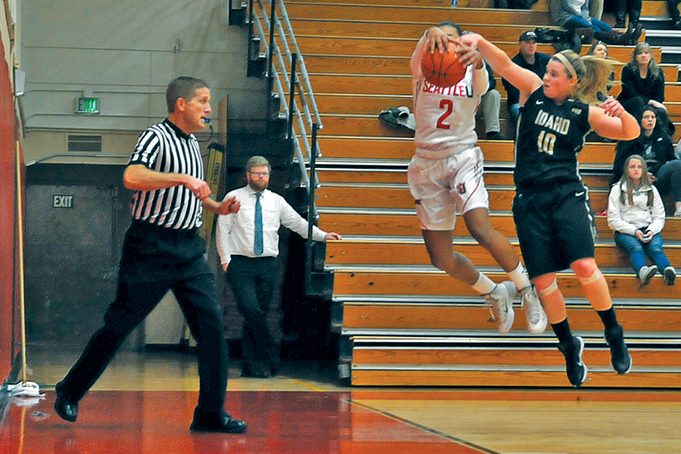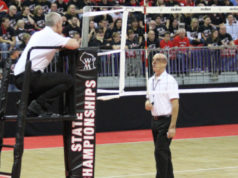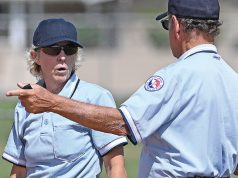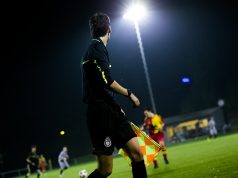The absence of an official’s whistle has its own characteristic sound — that of continued action. That silence is thought to bring an official further along the line which ends at the point where “impact of officiating on event outcome” equals zero.
That line is, to borrow an analytic geometry term, asymptotic because it never quite reaches zero. Officials always have an impact on their sporting events. About nine percent of the plays in the 2013-14 NFL season included a penalty call, and more than 25 percent of possessions in typical NCAA basketball games last season featured a referee’s whistle. However, the other 91 percent of NFL plays and 75 percent of NCAA possessions featured “no-call” decisions by the officiating crews which had just as much influence on outcomes as did the penalties and fouls that were called.
Many situations officials face are “boundary” decisions that require great eyesight and proper positioning but minimal judgment or discretion. Boundary calls are mandatory; a baseball or softball pitch not hit by the batter must be called a ball or a strike. The volleyball attack that hits the floor near the line must be called in or out. Sports which rely heavily upon boundary calls are not sports in which an official has the luxury or the duty of the occasional no-call.
Boundary decisions may lack the no-call dimension, but that doesn’t mean they are simple. As technology improves, even some formerly clear-cut boundary calls are becoming ambiguous. For almost 100 years, first-base umpires faced an uncomplicated binary question — did the runner’s foot hit the base before or after the first baseman caught the ball? At the major league level, technology has made that question a metaphysical discussion that requires a careful definition of the word “caught.” Networks now use advanced cameras to capture action on the field at a rate of 1,400 frames per second (fps), about 60 times the rate of the cameras major studios use to make movies. When viewing the resulting ultra-slow-motion replay, one can actually see an interval between the instant a ball strikes the web of the first baseman’s glove and the moment the player actually closes the glove around the ball to secure it. At 1,400 fps, a “catch” isn’t an event; it’s a process. At what point in that process is the ball considered caught? The better video technology becomes, the more sense it makes to use the ears to adjudicate close calls at first base. After all, they’re called “bang-bang” plays for a reason.
For a sport premised on contact and collisions, football’s officiating crews also spend a lot of time making boundary calls. Out of bounds or inbounds? Touchdown or no touchdown? Officials must decide.
While boundary calls must be made, officials have discretion when it comes to players bumping into each other. Contact between opposing players is inevitable, whether it is designed as a principal part of the sport as in football and ice hockey or a peripheral aspect as in soccer and basketball.
Effective officials know their role is not to interject their whistle at every opportunity, but only when necessary. The whistle not blown is sometimes greeted with an acknowledging nod from an officiating partner and perhaps even a player or coach with a quick “good no-call.” The reality that taking no action is sometimes the best action is often contrary to both the personality and training of an official.
Those who seek to become sports officials are often accustomed to being in charge of people and events. It’s no coincidence the officiating community includes many with law enforcement backgrounds, military experience or both. Among the very first things new officials are taught are the tools necessary to take control of a sporting event — how to dress and behave to be perceived as a legitimate authority figure, how to blow the whistle decisively, how to deal firmly with players and coaches and how to assess penalties and fouls to those who break the rules. Officials are thus taught both implicitly and explicitly their role is to be in charge and to take action.
Combining people who are assertive with action-oriented training programs produces a predictable result: officials who are controllers rather than managers. The official as focal point rather than facilitator is an understandable outcome, but knowing when not to take action is also important to advance.
“Early in your officiating career you think you’d like to be in the biggest game ever played and be the official that makes the call at the end of the game to determine the outcome,” explained Gerald Austin, a former NFL referee with three Super Bowl assignments. He is now serving as coordinator of officials for Conference USA. “Once you get some experience you come to understand that is not your role. Your role as an official is to put the players in position to make the plays at the end of the game that will determine the outcome,” he said.
Bill McCreary, a former NHL referee who was inducted into the Hockey Hall of Fame last November, believes the “whistle restraint” he displayed in the 1994 playoffs was instrumental in the league’s recognition of his readiness to work the Stanley Cup Finals.
McCreary was the referee for the seventh game of the 1994 Eastern Conference finals between the New Jersey Devils and the New York Rangers. Media coverage of the game was unprecedented. Ranger captain Mark Messier had guaranteed that his team would win game six. Win they did, with Messier scoring three of New York’s four goals.
With all that drama in place for game seven two nights later, McCreary guided the teams through not only three periods of excruciating elimination game tension but also a full overtime period as well. Eighty-four minutes of ice hockey in Madison Square Garden featured just a single minor penalty called on each team and many no-calls.
The Age of Analytics is upon us, and everything that can be counted in sports is being counted and then categorized, collated, classified and analyzed. Quants (experts in quantitative analysis) armed with spreadsheets instead of trumpets have, over the past decade, taken it upon themselves to bring down the Jerichoan walls of conventional wisdom and gut feelings. Somewhere there is an analyst who can tell you what pitch a pitcher throws 90 percent of the time when the count is 1-2. Another analyst knows how many feet beyond the halfcourt line players will allow a ballhandler to penetrate before they begin to defend aggressively.
There are also analysts who can identify which officiating crew is most likely to toss more than the average number of penalty flags during a football game or whistle a high number of fouls during a basketball game. That information is no longer limited to unsavory corners of the Internet patronized by people looking for a point-spread edge. No less a mainstream source than ESPN includes a column called “Inside Slant” under its NFL Nation blogroll which lists the average number of penalties called by each of the NFL’s crews.
It’s no longer just players and coaches whose actions and decisions are being publicly dissected and quantified. Coordinators responsible for assigning and promoting (and demoting) officials have access to data which can either reinforce or refute previously held opinions. Teams and officials can subscribe to multi-media, interactive databases like QwikRef that document penalties and fouls called at the Division I and professional levels, as well as identify the official who made each decision. In many instances, QwikRef will also include video of the play which prompted the call.
“The coordinator now has a tool to evaluate, analyze, assess and train his staff,” said QwikRef creator and proprietor Rusty Acree, a Naval Academy graduate who officiated Division I football for more than 10 years and now works as a video replay coordinator for the Atlantic Coast Conference. “Coordinators will still have their gut feelings about whether or not somebody can officiate, but now they have some metrics to validate or invalidate their instincts.”
EFFECTIVE OFFICIALS KNOW THEIR ROLE IS NOT TO INTERJECT THEIR WHISTLE AT VERY OPPORTUNITY, BUT ONLY WHEN NECESSARY.
That availability of pre-logged and pre-sorted officiating data, combined with the supporting video, allows coordinators like Austin and the Big Ten’s Bill Carollo to identify “outliers” who make a significantly greater number of penalty or foul calls compared to peer officials who work under comparable conditions (crew position, competing teams, etc). Of course, the evaluator or coordinator must put the raw data into context in order to draw useful conclusions. That is where video becomes crucial. There’s a good reason some teams draw more penalties and fouls than others; it is because they deserve them.
“When a crew goes into a game and calls a lot more fouls than they did in the game before, you should know if it’s a team that commits more fouls,” Austin said. “Then, you understand why the crew called more fouls than they did the week before.”
Carollo, a 19-year NFL official who made two Super Bowl appearances, one as referee, said the average Big Ten game from 2013 included about 180 plays, 12 to 13 penalties, and usually three or four plays that saw an official cited for a correct no-call. No-call situations and plays where penalties are called are graded the same way and carry equal weight — coordinators place equal value on officials knowing when not to blow the whistle as officials calling penalties correctly.
“An official can go a whole game and never throw a flag,” said Carollo. “My attitude is, ‘Don’t tell me he had a bad game because he didn’t call anything.’ Sometimes there’s nothing to call, and the official will get credit for that just as if he had called something. An official sometimes makes a major decision not to call anything, and I think he should get credit for that.”
A typical 180-play game that includes 12 penalties also includes 168 non-penalized plays. That does not mean there were 168 noteworthy no-call decisions.
“The officials don’t get extra credit for just doing their jobs,” Carollo said. “They do get credit for making a tough no-call and getting it right.”
There is a major difference between the missed call and the no-call. Missed calls are cases when a rule is applied incorrectly, or when an official is out of position and is unable to make an informed decision. Missed calls can be classified as mistakes of either commission or omission.
“There are two sins in football officiating,” Austin said. “One is making an incorrect call. The other is not making a call when it should have been made. The greater of the two sins is an incorrect call, because now you have penalized someone for something they did not do.”
“The conferences that use QwikRef downgrade an incorrect call more severely than they do (for those) not calling a penalty that did take place,” Acree said. “The term the conference coordinators use is ‘phantom flags.’ Those are what we want to avoid the most.”
The no-call is not a mistake — it is an official making a conscious decision not to intervene. Officials face two primary situations where a no-call is the appropriate response. In the first case, the “gray area” scenario, the circumstances of the rules violation are so murky and ambiguous they don’t justify an official’s intervention. In the second case, the rules violation is evident but there are other factors that prompt an official not to intervene. That can be a risky time to employ a no-call because the official may have to justify a decision not to enforce a written rule, and that is also the time when an official is expected to employ sound game management techniques.
At lower levels an official may no-call a non-safety-related foul in a one-sided, running-clock contest because explaining and enforcing a rule would take away from precious game time. The only game action many fringe players ever see comes during blowouts, and they would rather play than observe an official call something in response to a minor infraction. An official may decide a no-call is the best response to an accidental foul or penalty where neither player is injured and they both return to normal play immediately, thus eliminating any potential advantage or disadvantage.
Soccer officials are particularly attuned to the importance of the no-call in large part because quality scoring opportunities occur far less frequently than in the other team sports. As a result, the game is best served by officiating that doesn’t intervene unless the referee is certain it’s warranted.
“Soccer referees will learn on the job more so than through formal training that if you’re not 100 percent sure, you probably don’t want to call it,” said Esse Baharmast, FIFA technical instructor. “It’s like the requirement to be guilty beyond the shadow of a doubt.”
THE NO-CALL IS NOT A MISTAKE — IT IS AN OFFICIAL MAKING A CONSCIOUS DECISION NOT TO INTERVENE.
Baharmast described a superb example of a no-call from the 2014 World Cup, the wisdom of which was validated less than 30 seconds later when the Swiss team that had been fouled scored the matchwinning goal. (Video of the play can be found on the FIFA website; Google search “Switzerland, Ecuador, World Cup, highlights.”) The no-call and subsequent action occurs in the final third of the two-minute clip.
The play illustrates how proper officiating sometimes means not blowing a whistle even when a foul occurs in view of 60,000 spectators.
The Swiss player moving the ball out of his own end during stoppage time was indisputably tripped on his side of the centerline. Baharmast credits Uzbekistani official Ravshan Irmatov with resisting the crowd’s initial reaction to the no-call as well as the impulse to call an obvious trip.
“He read the play well and he was astute enough to hold his whistle despite the stage of the game and the crowd reaction,” noted Baharmast. “He saw there was a possible advantage for the Swiss and 30 seconds later the Swiss fans in the crowd were thankful for the no-call.”
While football, soccer, hockey and other sports present officials with call/ no-call decision points, no sport may present more of them than basketball.
“The entire game is one long no-call,” noted Steven Angel, the NBA’s senior vice president for referee operations and analytics. A former compliance officer with the Securities and Exchange Commission, Angel and his colleagues worked with the league to design the current referee program, which the league’s website describes as a “data-driven effort to collect and analyze referee performance.” Angel provides a thoughtful explanation of the NBA’s philosophy that if a referee’s whistle is silent, it’s because there was not a foul or a violation.
“Referees are instructed to make the calls they see and not make the calls they don’t see,” he said. “If they see a violation occur they are instructed to blow the whistle. When a referee does not blow his or her whistle but should have, it is considered a mistake. NBA referees are not given discretion in making calls, but they do exercise judgment as to whether a foul or violation occurred. They have to see the play occur and they have to process it — in fractions of a second. We use data to identify patterns that might explain why a referee misses calls and work with him or her to improve, even when those opportunities to improve are around the edges. We want to make sure each call is made on its own merits.”
As Angel’s job title implies, the NBA makes extensive use of analytics to evaluate and develop its officials.
“If patterns are identified in the data that show a referee is missing calls (i.e, not blowing his or her whistle when a violation or foul has occurred), we’ll try to work with them to figure out what is happening. Is the referee in proper position? Is he or she looking in the right place? And (we) help the official identify those calls that should be made,” Angel said.
Contact sports don’t merely present opportunities for no-calls, they demand them. Officials who call every conceivable foul or penalty will find themselves presiding over an athletic event which satisfies no one, including assigners.
The officiating community frequently uses the term “game management” to cover areas of judgment officials are expected to employ as they perform their duties. The no-call may be the single most important aspect of game management for all officials. As counterintuitive as it may seem, what officials don’t call may have more impact on their ultimate success than what they do call.
“While we don’t formally track calls that could possibly be made but are not made, our replay officials make note of them,” said Austin. “We try to get everyone on the same page philosophically, and that philosophy is when an official sees something that might be a foul, the official should read the play and say, ‘That’s a foul … that’s a foul,’ and then throw (a flag.) You need those two internal confirmations, and that means there’s enough there to justify a flag. If you say, “That’s a foul … I’m not sure,” then keep (the flag) in your pocket.”
As officials gain experience, most realize it is important to suppress the impulse to jump in at every opportunity. Effective officiating requires the ability to bring order to inherently chaotic activities without smothering the participants. Action oriented officials who have received action-oriented training learn through experience that it is sometimes best to decide not to take action.
What's Your Call? Leave a Comment:
Note: This article is archival in nature. Rules, interpretations, mechanics, philosophies and other information may or may not be correct for the current year.
This article is the copyright of ©Referee Enterprises, Inc., and may not be republished in whole or in part online, in print or in any capacity without expressed written permission from Referee. The article is made available for educational use by individuals.



















